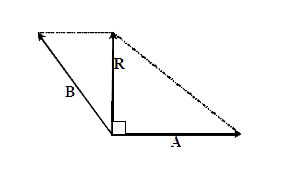The vector sum of two forces is perpendicular to their vector differences. In that case, the forces
are not equal to each other in magnitude
are parallel
are perpendicular
are rqual to each other in magnitude
The correct Answer is:D
To solve the problem, we need to analyze the given condition that the vector sum of two forces is perpendicular to their vector difference. Let's denote the two forces as vectors A and B.
1. Understanding the Condition:
We are given that the vector sum of two forces is perpendicular to their vector difference. Mathematically, this can be expressed as:
(A+B)⊥(A−B)
2. Using the Dot Product:
For two vectors to be perpendicular, their dot product must equal zero. Therefore, we can write:
(A+B)⋅(A−B)=0
3. Expanding the Dot Product:
Now, we expand the left-hand side:
A⋅A−A⋅B+B⋅A−B⋅B=0
Since the dot product is commutative (A⋅B=B⋅A), we can simplify this to:
|A|2−|B|2=0
4. Setting the Equation:
This simplifies to:
|A|2=|B|2
Taking the square root of both sides gives us:
|A|=|B|
5. Conclusion:
The magnitudes of the two forces (vectors) are equal. Therefore, the correct answer is that the forces are equal in magnitude.
Final Answer:
The forces are equal to each other in magnitude.
---
We are given that the vector sum of two forces is perpendicular to their vector difference. Mathematically, this can be expressed as:
(A+B)⊥(A−B)
For two vectors to be perpendicular, their dot product must equal zero. Therefore, we can write:
(A+B)⋅(A−B)=0
Now, we expand the left-hand side:
A⋅A−A⋅B+B⋅A−B⋅B=0
Since the dot product is commutative (A⋅B=B⋅A), we can simplify this to:
|A|2−|B|2=0
This simplifies to:
|A|2=|B|2
Taking the square root of both sides gives us:
|A|=|B|
The magnitudes of the two forces (vectors) are equal. Therefore, the correct answer is that the forces are equal in magnitude.
The forces are equal to each other in magnitude.
Topper's Solved these Questions
Similar Questions
Vector sum of two forces of 10N and 6N cannot be:
View SolutionVector sum of two forces of 10N and 6N cannot be:
View SolutionThe resultant of two vectors is perpendicular to first vector of magnitude 6N. If the resultant has magnitude 6√3N, then magnitude of second vector is
View SolutionThe sum of two vectors A and B is at right angles to their difference. Then
View SolutionThe sum of two vectors A and B is at right angles to their difference. Then
View SolutionThe sum of two vectors A and B is at right angles to their difference. Then
View SolutionTwo forces are such that the sum of their magnitudes is 18N and their resultant is 12 N which is perpendicular to the smaller force. Then the magnitude of the forces are
View SolutionWhat is the condition for perpendicularity of two vectors ?
View SolutionThe resultant of two vectors A and B is perpendicular to the vector A and its magnitude is equal to half the magnitude of vector B. The angle between A and B is -

View SolutionIf the magnitude of sum of two vectors is equal to the magnitude of difference of the two vector, the angle between these Vector is
View Solution
